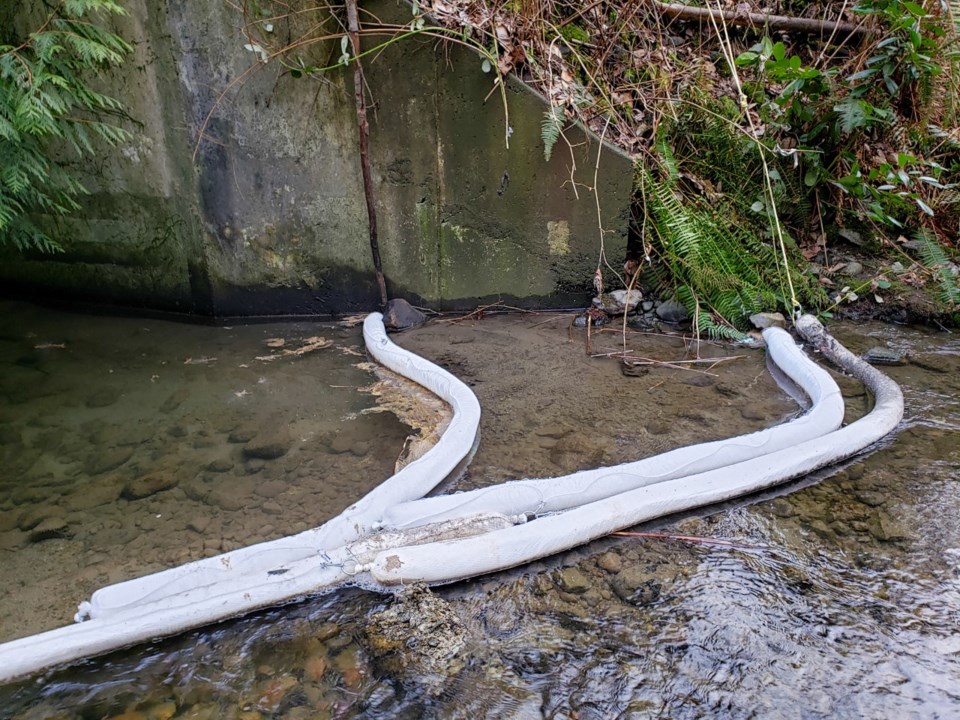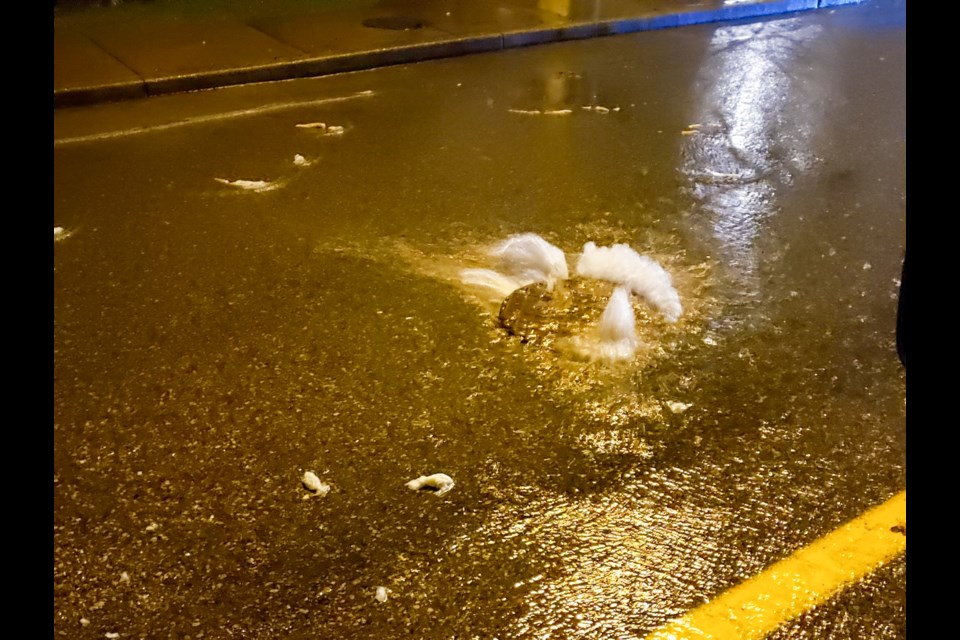Residents near Coquitlam’s Oakdale Park are raising the alarm after recent torrential rains caused a manhole to burst its cover, spewing raw sewage into the air and on to North Road.
The fecal fallout has rankled area residents George and Suzana Kovacic, who emailed photographs to the city of Burnaby after they noticed an awful smell and wads of partially disintegrated toilet paper littering the road.
And while the couple hasn’t heard back, The Tri-City News has confirmed with the city of Coquitlam the manhole belongs within its jurisdiction and sewer network.
Public works staff brought in a hydro-vac truck Saturday to dislodge any blockages that could have led to the manhole overflowing but the Kovacics and others in the area are concerned the latest overflow is but a spike in a long line of contamination.
The contamination is especially disconcerting, they say, because the sewage overflowed in front of Oakdale Park where their children play, before it ran downhill towards two nearby storm drains that empty into Stoney Creek.
According to Brad Lofgren, Coquitlam's director of public works, the city’s sewer system is complex due in large part to “the radical topography within Coquitlam."
Once it leaves the municipality, Coquitlam’s collective sewage empties into Metro Vancouver’s trunk sewer system before ending up in one of the region’s treatment facilities, he said in an email.
The system is both well designed and properly maintained, Lofgren said, but under extraordinary circumstances, such as the extreme rain event last week — one where 175 millimetres of precipitation dropped on parts of the city in 36 hours — some rainwater inevitably seeps into the sanitary sewer system.
That seepage usually occurs through “illegal cross-connections on private property,” said Lofgren, including rainwater leaders and sump pumps connected to the sanitary system. This happens all over Metro Vancouver, overloading sewers with diluted sewage with nowhere to go, he said.
The manhole that overflowed in front of Oakdale Park on North Road last Friday is close to a junction that dumps Coquitlam’s sewage into the Metro Vancouver system. So when the Metro system started backing up Jan. 31, it found an escape hatch through the manhole on North Road, a low point in that area of the system, said Lofgren.
But while this was the worst incident George Kovacic said he has seen so far, he said the manhole has been overflowing for nearly a decade.
“It appears that these incidents are happening more frequently, more often and for a longer time,” he said, adding he doesn’t chalk it up to a changing climate but on pressures on aging infrastructure.
“You can do all the development you want but before you do massive development, you have to make sure you have all the infrastructure in place,” he said. “It’s just because we can’t see it. It’s out of mind.”
It’s not the first time toxic effluent has been spotted contaminating the catch basin that flows into Stoney Creek. Between January and April of 2019 and intermittently thereafter, the Kovacics noticed an oily substance percolating downslope into the creek bed.
After they contacted the city of Coquitlam with their concerns, public works staff installed booms around the outflow of the culvert leading into the stream in an attempt to capture an unidentified liquid that was thought to be petroleum-based.
Lofgren said most of the incidents have been traced back to illegal discharges from private properties or construction sites into the storm system. The contamination, he noted, can be both difficult and time consuming to source, though on some occasions, have resulted in fines.

John Templeton, president of the Stoney Creek Environmental Committee, said one of the big challenges in stemming the contamination of Stoney Creek results from overlapping jurisdictions — in particular, a culvert shared by Coquitlam and Burnaby.
“[Residents] will see oily water [and] call Burnaby. They’ll say, ‘Call Coquitlam.’ By the time Coquitlam gets involved. It’s gone,” he said. “I’ve talked to the city of Coquitlam many, many times about this. It’s always the same story: ‘We can never find it.’”
Whether due to effluent cascading downslope from worksites in Burquitlam or Coquitlam sewers percolating into a Burnaby stream, it all can cause lasting damage to a sensitive watershed already reeling from one of the worst salmon returns in recent years.
A good year in Stoney Creek sees close to 2,000 salmon returning to spawn, whereas a medium-sized run falls somewhere between 600 and 800 fish, said Templeton. Last year, just 150 chum returned.
“According to [Fisheries and Oceans Canada], we need 500 fish to spawn successfully and bring back the next generation,” Templeton said. “We’re in trouble, serious trouble.”
Any environmental impact will likely fall on both sides of the municipal border. Stoney Creek feeds into the Brunette River, which eventually makes its way into the Fraser. But up the creek, part of the watershed branches west into Coquitlam, and coho and chum salmon are known to reach as far as Chapman Avenue, about 500 metres north of the bubbling manhole.
In an email, Lofgren told The Tri-City News that threats on the watershed from sewage overflow should be reduced as the city and Metro Vancouver move to upgrade the area’s sanitary sewer system over the next few years. That work is aimed at ensuring there is enough capacity to handle the volume of sewage produced by future high-density developments.
CORRECTION: An earlier version of this article stated that the Kovacics noticed a petroleum-based liquid leaking into Stoney Creek last summer. In fact, they first noticed it between January and April 2019, and intermittently thereafter.
Read more about local waterways:
PoCo contamination culprit found



